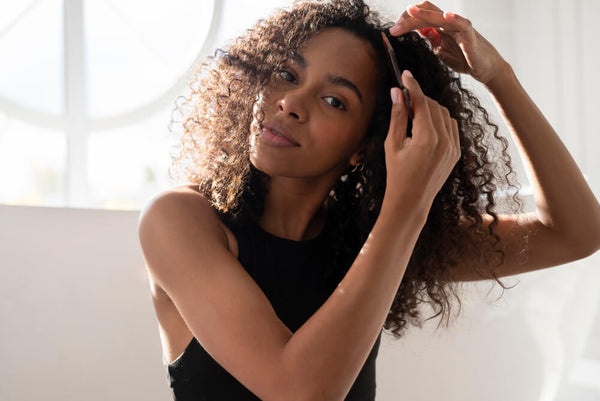It’s a pattern you might start to recognize. As the leaves turn or the flowers bloom, you find yourself staring at a little more hair in your comb, a few more strands circling the drain. You tell yourself, "It's just that time of year again," but a quiet worry settles in. Is this normal, or is my hair trying to tell me something?
That feeling is so valid. While a minor increase in shedding with seasonal shifts is a real phenomenon, for us as Black women, it’s rarely just about the season. It’s often the straw that breaks the camel's back.
At Nina Ross Hair Therapy, we see this all the time. A client comes in worried about "seasonal shedding," and our comprehensive testing reveals an underlying issue that's been simmering for months—like low ferritin (stored iron) or a hormonal imbalance. The season change simply pushed a vulnerable system over the edge.
The Real Reason You Shed More Hair When Seasons Change
So, is seasonal hair loss even real? The short answer is yes, but probably not for the reasons you think.
It’s not that the weather itself magically makes your hair fall out. Think of it as a physiological stress response. Our bodies are deeply connected to our environment. Changes in sunlight exposure affect our melatonin and prolactin levels, hormones that can influence your hair growth cycle.
This can cause a larger number of hairs than usual to simultaneously enter the resting (telogen) phase. About 2-3 months later, those hairs shed. This condition is called Telogen Effluvium.
The problem? If your hair and scalp are already under stress from other factors—common for us with styles like braids or weaves, or conditions like CCCA—this "normal" seasonal shed can feel much more dramatic and recovery can be slower.
Is It Truly Seasonal? Or a Sign of a Deeper Problem?
This is the most important question to ask. Here’s how we help our Atlanta clients tell the difference:
Normal Seasonal Shedding
A slight, temporary increase in shedding (lasting 4-6 weeks) that occurs around the same time each year (often late fall and early spring). The hair loss is diffuse—meaning it's all over, not in specific patches—and your hair density generally bounces back on its own.
A Red Flag Disguised as Seasonal Shedding
The "shedding" doesn't stop after 6-8 weeks, you're noticing actual thinning or a change in your hairline, or it's accompanied by other symptoms like scalp tenderness, bumps, or itching. This is especially crucial if you have a history of traction alopecia or CCCA.
A key insight from our practice: Many of the clients who come to us thinking they have seasonal hair loss actually have an underlying case of Telogen Effluvium that was triggered by an event months prior (like a stressful life event, a change in medication, or a viral illness), and the timing with the season was just a coincidence. This is why investigating the root cause is non-negotiable.
Why Melanated Hair Feels the Impact More
Our textured hair is beautiful, but its growth cycle is inherently more fragile. The curl pattern makes it more susceptible to breakage, and styles that protect our hair can also create tension. When you add a seasonal shed on top of this, the loss feels more significant.
Furthermore, common issues we see in our community—like Vitamin D deficiency (which is widespread) and low iron stores—can prime your hair for excessive shedding. The seasonal shift can definitely act as a trigger at times but the nutrient deficiency is the main vulnerability. This is a gap most dermatologists may completely miss.
Beyond "Eat Well and Air Dry": Here’s A Functional Approach to Stabilize Your Hair
Generic advice like "take a multivitamin" and "use less heat" may work but not all the time. It doesn't address the biochemical individuality of your hair loss. Our approach is different in various ways.
-
We Start with Advanced Diagnostics
Instead of guessing, we use comprehensive lab testing to check your ferritin (iron stores), Vitamin D, Zinc, and Thyroid function. These are the most common culprits we find that exacerbate seasonal shedding into something more chronic.
-
We Fortify from the Inside
Based on your test results, we create a personalized plan of medical-grade nutraceuticals for you. It won’t be a generic biotin pill but will include what your body is actually missing to build a resilient foundation for hair growth.
-
We Protect and Activate the Follicles Directly
While we support your body internally, we can use advanced treatments to calm the scalp and encourage regrowth. Our PRP (Platelet-Rich Plasma) Therapy delivers a concentrated dose of your own growth factors directly to the follicle. This helps shorten the resting phase and jump-start the growth cycle. For even more potent results, we offer Exosome Therapy.
Don't Just Blame the Season
Your hair is a barometer for your internal health. While a little seasonal shedding is normal, persistent or worsening thinning is your body’s way of asking for help.
If you're tired of the same shedding cycle year after year, it's time to investigate why. As Atlanta's leading functional medicine hair specialist, Nina Ross Hair Therapy is here to help you get to the root of it. Book your $99 Hair Therapy Evaluation today, and let's create a plan that ensures your hair thrives in every season.














